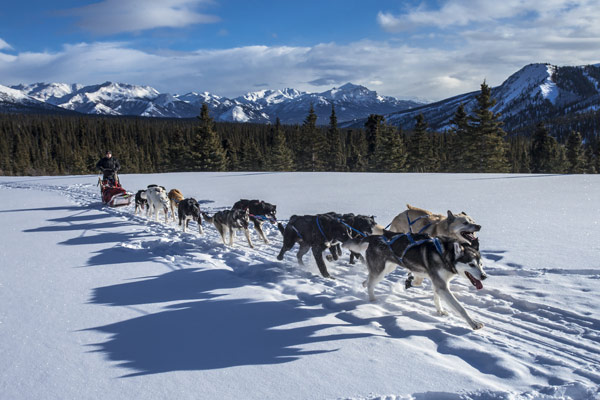Distance Learning
- Grade Level:
- Upper Elementary: Third Grade through Fifth Grade
- Subject:
- Science

Did you know that park rangers use sled dogs to perform winter work in Denali National Park and Preserve? But why? Join us to learn about why these amazing animals are perfectly ADAPTED to a cold, subarctic environment. Take a deeper dive into what makes the tails, fur, feet, tongues, and dispositions of Denali’s sled dogs so good for their snowy, hard work!
Program Length and Grade Range
This 50-minute program is designed for students in grades 2–4.
How to Participate
Denali's Distance Learning programs are a fun and interactive way for our education rangers to visit your classroom for free!
Our Distance Learning presentations are available from November 1 through March 31 annually (with breaks around some major holidays). Registration begins on October 15th annually. Spaces are limited and registration is handled on a first-come, first-served basis.
You will find the link to our Distance Learning Registration Form on Denali's Distance Learning homepage.
A recorded version of the Science of Sled Dogs is available for teachers to use with their classes. Similar to a live presentation, there is room built in for discussion. Prompts to pause the video allow teachers to facilitate a discussion with students in the same way they might discuss the topic with a ranger.
The Science of Sled Dogs—Teacher's Guide
Program Objectives
Students will:
- Learn that Denali National Park and Preserve is a National Park in the subarctic where animals need to be adapted to survive and thrive in the cold.
- Learn about 5 adaptations that sled dogs have that make them so good at their jobs in the subarctic.
- Learn the difference between physical and behavioral adaptions.
- Discuss how the adaptations of Denali’s sled dogs may or may not be helpful as winters in Denali get warmer due to climate change.
- Discuss the adaptations of wild animals that live near the students’ homes.
Next Generation Science Standards Addressed
- 3-LS1-1, 3-LS3-1, 3-LS3-2, 3-LS4-2, 4-LS1-1
Vocabulary and Concepts Covered
- Adaptations, climate, environment, subarctic, breeding for traits, compact feet, insulation, environmental change
Before the Distance Learning Program
- Assign or read aloud the Sled Dogs of Denali student reading and the Denali Overview for Students.
- Optional: Play the short video "True Heart of Winter".
- Optional: Explore other resources linked under the Sled Dogs section of Denali’s Educational Resources page.
- Ask the students to think about the natural world and environment near their homes. Have them consider the following questions:
- Can you describe what the temperatures are like near your home? What types of clothing do you wear outside in winter versus summer?
- What about types and amount of precipitation? Do you ever have storms? What kinds? Can you describe an average day of weather in the place you live? How about an extremely stormy day you’ve seen?
- What types of wild animals live in your area? What are some traits they have, like how much or little fur, do they live in the water, do they fly, etc.?
- We love chatting with students about Denali! Encourage your learners to think of questions to ask the ranger. We usually have time at the end of a program to answer questions, and we're happy to answer overflow questions via e-mail.
- Make sure you have a Zoom link at least a week ahead of time.
During the Distance Learning Program.
- The teacher is responsible for classroom management during the program. This includes calling on students throughout the program and helping to ensure that their answers and comments are understood by all. The teacher is also responsible for facilitating questions at the end of the program.
After the Distance Learning Program
- Email us your questions, feedback, or an evaluation form. We love hearing ways that we can continue to improve our programs!
- Post-activity suggestions:
- Have students imagine a sled dog without its subarctic adaptations. Share a picture of a dog adapted for warm weather (like a Chihuahua) and tell the class that the dog is heading to Denali to work with the sled dogs for the winter. Ask how they will help the dog be ready for the subarctic. Their job is to dress the dog up with clothes and gear so it is ready for the winter trail patrol. Brainstorm what the dog will need (parka, boots or mittens, raincoat, scarf or fuzzy muffler on its tail, boots and snowshoes, etc.).
- Draw an imaginary animal that would be wonderfully adapted to each of these environments: HOT and DRY, WET and COLD, SNOWY and WINDY. On your drawing, circle the animals’ adaptations and draw lines with descriptions of what they are.
Last updated: February 6, 2025
